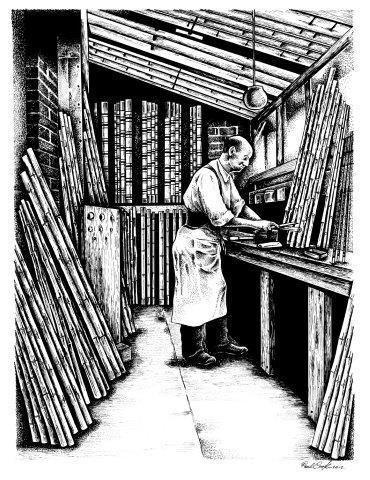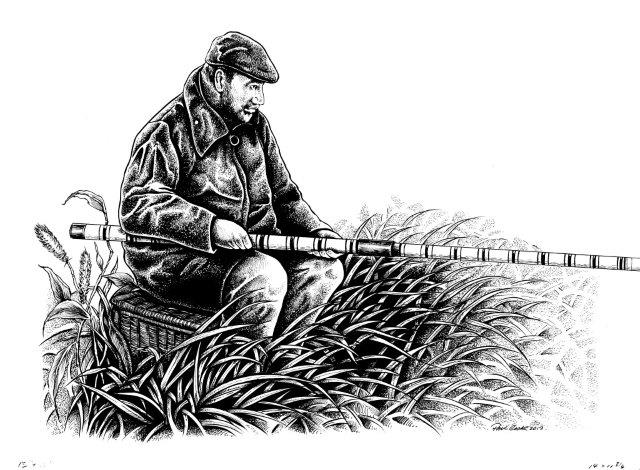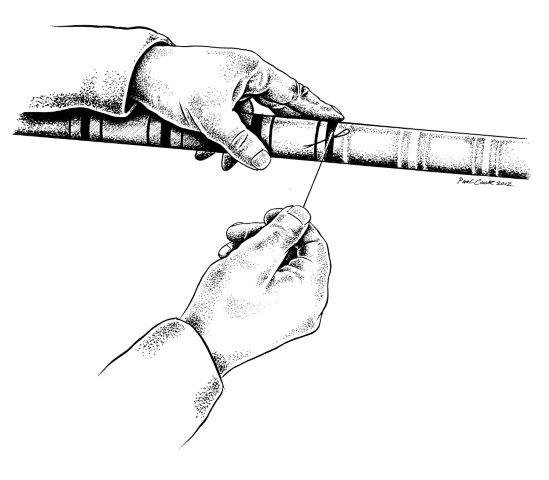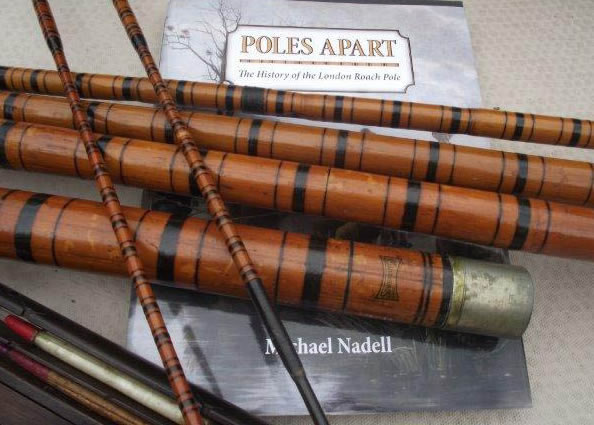
London Roach Pole
 Ask any collector of Vintage Fishing Tackle who they would associate with the London Roach Pole and the name Sowerbutts would come to mind. Sowerbutts were the longest serving pole makers of their time and the company name ran over 9 generations beginning in 1770 right up until the shops closure in 1984.
Ask any collector of Vintage Fishing Tackle who they would associate with the London Roach Pole and the name Sowerbutts would come to mind. Sowerbutts were the longest serving pole makers of their time and the company name ran over 9 generations beginning in 1770 right up until the shops closure in 1984.
There were other pole makers besides Sowerbutts such as Creeke, Bazin and Evans to name but a few, but the one to equal the skill of Sowerbutts was Evans. Each pole maker had their own individual style when building their poles but none could match the output of Sowerbutts who were the leading makers producing greater numbers of poles in comparison to others. To be fair, Sowerbutts were a family run business employing a number of skilled craftsman where as the other makers were individuals who worked mainly alone.
Perhaps then this is why the name Sowerbutts is so well known and they were the masters of their trade.
Author, historian and Roach Pole collector Michael Nadell has had a deep interest in the makers of London Roach Poles especially Sowerbutts since an early age and has accumulated over 50 years of knowledge and experience within this fascinating part of our angling history. It soon became apparent that the historical facts, the makers and the men who fished the pole needed to be catalogued in one form or another through fear of it being lost forever. It was enevitable that a book was forthcoming.
In 2013, Poles Apart, The History of the London Roach Pole was first published, the very first of its kind to deal with the authors favourite maker Sowerbutts and other well known and not so well known London Makers. Not only does the book cover all aspects of the making of the Roach Pole, it also delves deep into the history of the makers as well as those who fished with the Pole along the banks of the famous Thames and river Lea.
Prior to the books publication, the Roach Pole as a collectable item sat largely unnoticed on the fringes of the collecting world. There were a few collectors who had the insight to appreciate that the roach pole, despite its cumbersome appearance was indeed a very well crafted piece of angling equipment.
Man has always crafted things from nature and fishing equipment is no exception, many vintage items of fishing tackle are made from natural materials and perhaps that is why in this fast changing modern world we can appreciate the things from our angling past. We have rods made from Green heart and seasoned split cane, reels made from various timbers and linewinders from seasoned rosewood. The coarse and game anglers are catered for by nature itself. Flies tied from bird feathers and floats made from bird quills, cork and wood, the list goes on.
 The roach pole is no exception, with the majority being made from Tonkin, Carolina cane, mahogany butt sections with tips made from whale bone, split cane and greenheart. The appreciation amongst pole collectors comes to the fore and now with the publication of this new work, the book has brought in a wider audience which has increased the interest in this much forgotten but important part of another chapter in our angling heritage.
The roach pole is no exception, with the majority being made from Tonkin, Carolina cane, mahogany butt sections with tips made from whale bone, split cane and greenheart. The appreciation amongst pole collectors comes to the fore and now with the publication of this new work, the book has brought in a wider audience which has increased the interest in this much forgotten but important part of another chapter in our angling heritage.
There is however a downside to all this and that is the increasing value of the London Roach Pole which is unfortunately, as with all angling artefacts,is now putting them out of the reach of your average collectors pockets. The same has happened with floats, they reached a peak a little while back but have now settled down, the same will happen with the Roach Poles but gone are the days when a pole was discarded to the garden shed to be long forgotten or worse still, used for growing your runner beans on!
Sowerbutts will always be the leaders in collectables but other less known makers will also become desirable and despite the output of the Sowerbutts brand it is surprising that few poles are ever found in mint unused condition.
The majority of pole anglers used their poles throughout their angling life and also being very expensive to buy, any damage or breakage was either dealt with by the owner or the original maker. With most though it was a case of make do and mend, few had the luxury to just go out and buy a new pole from one of the top makers or even pay for repairs by a professional.
This now brings us to the sometimes difficult and frustrating process of restoration. Roach Poles were used extensively and as with all tackle, would at sometime suffer damage from broken joints and splits within the bamboo sections.For those familiar with rod restoration will have come across some often very clever modifications expertly carried out by a fair hand but this is rare, most of the modifications or repairs have been homemade and pretty poor to say the least. This can frustrate the restorer and if you have no historical reference to aid you within the work then it becomes difficult.I have however been fortunate to have worked on many poles over the years and the vast majority have been from the authors private collection.With the invaluable knowledge of Michael Nadell, the various problems encountered regarding a particular build to a pole has always been overcome due to the  experience of the author.
experience of the author.
One particular pole gave us a both a headache and we could only assume the owner got bored and decided to strip the pole down and re whipp it himself. It was a very neat job to be fair and had been done some time ago as the aged cane and shellac looked right for its period. The pole itself was a very neat lightweight Sowerbutts Lea pole. The give away were the original “witness” marks left on the cane from where the original whipping pattern had been. These “witness “marks will be apparent to any rod restorer and in the case of restoration can prove to be a headache to hide as the restorer is left with a dilemma. The new whipping will also leave witness marks thus leaving the rod or pole with an ugly appearance which is hard to hide. Witness marks can be removed but this is a painstaking procedure and only adds to the workload of the restorer. This change of pattern seems to be a common occurrence with old rods and poles from the past, but the decision lies with the restorer and it is always better to work to the original pattern.
Working on various Poles over the years has given me more of an insight into the skills of these past makers. They were clever men, no machinery involved, just the eye and hand, a true testament to the long forgotten skills of our angling past.
Anyone who is interested in further reading about the history and makers of the London Roach Pole the book is now available from the publishers, Paul Morgan at Coch-Bonddu-Books www.anglebooks.com
